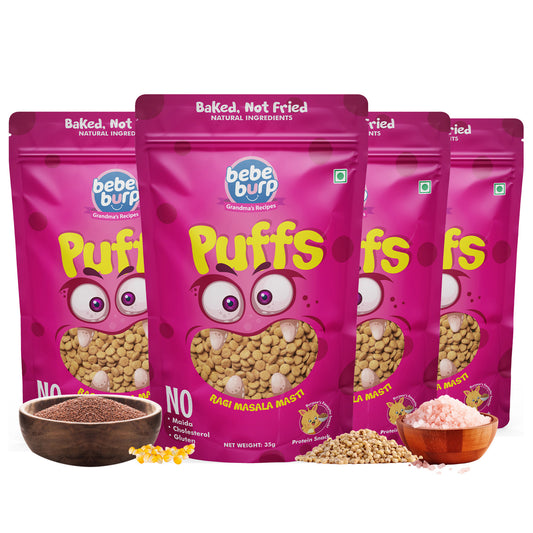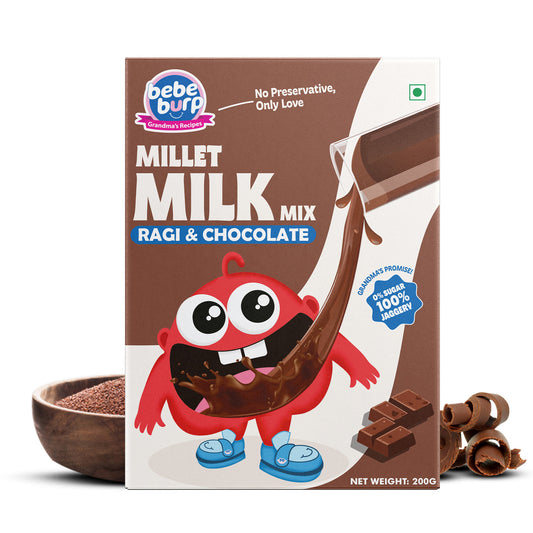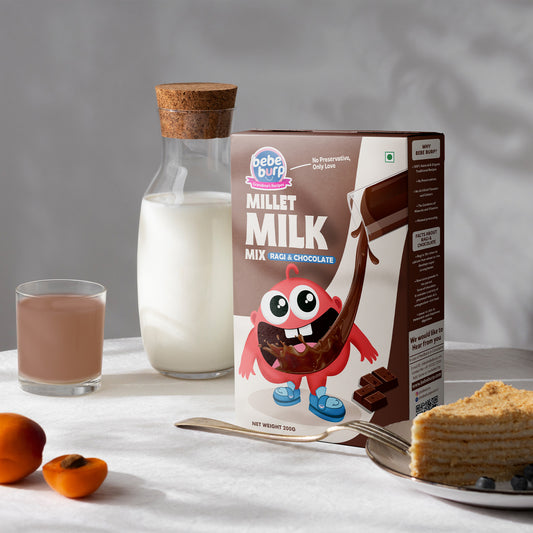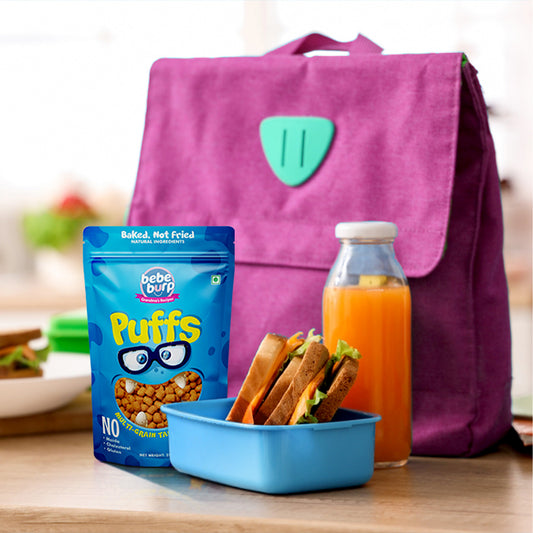INTRODUCTION
In recent years, there has been a notable surge in the interest surrounding gluten-free diets for babies. This heightened attention can be attributed to a growing awareness of gluten sensitivities and celiac disease, as well as a desire among parents to promote optimal health and nutrition for their little ones. As part of this gluten-free lifestyle, certain alternatives gain prominence, and one such nutritional gem is ragi. With its inherent gluten-free nature and a plethora of essential nutrients, ragi has emerged as a compelling choice to support the well-being and growth of infants on gluten-free diets. Let's explore the significance of ragi, is ragi gluten free, and its relevance in nurturing a wholesome gluten-free lifestyle for babies.
UNDERSTANDING GLUTEN AND GLUTEN SENSITIVITY
Gluten, a protein composite found in grains like wheat, barley, and rye, plays a significant role in the culinary world. However, for some babies, gluten can trigger adverse reactions leading to gluten sensitivity or celiac disease. Gluten sensitivity refers to a condition where individuals experience unpleasant symptoms, such as bloating, abdominal pain, diarrhea, and fatigue, when consuming gluten-containing foods. On the other hand, celiac disease is an autoimmune disorder wherein the ingestion of gluten leads to damage to the small intestine, impairing nutrient absorption. This chronic condition can result in more severe symptoms, including weight loss, malnutrition, skin rashes, and stunted growth. Recognizing the common symptoms and health implications of gluten intolerance is crucial for parents and caregivers to ensure the well-being and proper nutrition of their babies on gluten-free diets.
RAGI AND GLUTEN
Ragi, also known as finger millet, is a highly nutritious grain that has been a staple food in many cultures for centuries. It is widely cultivated in regions of Africa and Asia, including India. Ragi is not only valued for its versatility but also for its exceptional nutritional profile. Traditionally, it has been used to make a variety of dishes, including porridge, roti (flatbread), and malted beverages.
Firstly, let’s answer the question - Is ragi gluten free? One of the key reasons why ragi has gained attention in the context of gluten-free diets is its inherent gluten-free nature. Gluten is absent in ragi, making it a suitable alternative for individuals with gluten sensitivities or celiac disease. This makes ragi an excellent choice for babies on a gluten-free diet, as it can provide essential nutrients without triggering adverse reactions.
When comparing ragi to gluten-containing grains like wheat, barley, and rye, the contrast becomes evident. While these grains contain gluten, ragi stands apart as a naturally gluten-free option. This distinction is particularly significant for individuals who need to eliminate gluten from their diets due to health reasons. Ragi offers a viable substitute without compromising on taste or nutritional value.
Furthermore, ragi brings a wealth of nutritional benefits to the table. It is a rich source of dietary fiber, calcium, iron, and essential amino acids, making it a valuable addition to a balanced diet. Its high fiber content aids in digestion and promotes satiety, while calcium and iron contribute to bone health and blood formation, respectively. The presence of essential amino acids helps support optimal growth and development in infants.
In conclusion, ragi emerges as a compelling choice for a gluten-free diet, particularly for babies. Its traditional usage, gluten-free nature, and nutritional advantages set it apart from gluten-containing grains. Incorporating ragi into a baby's diet can provide a diverse range of nutrients while ensuring compatibility with gluten-free lifestyles.
RAGI AS A GLUTEN-FREE ALTERNATIVE
Ragi, or finger millet, has gained recognition as a remarkable gluten-free alternative with its impressive nutritional profile and numerous health benefits. Packed with essential nutrients, ragi offers a range of advantages for individuals following a gluten-free diet. This grain is a rich source of dietary fiber, providing excellent digestive support and promoting healthy bowel movements. Additionally, ragi contains significant levels of calcium, iron, and phosphorus, contributing to bone strength, blood formation, and overall energy levels.
Let’s cover a few aspects on is ragi gluten-free and its benefits. Choosing ragi as a gluten-free grain option brings several benefits. Firstly, it allows individuals with gluten sensitivities or celiac disease to enjoy a diverse and fulfilling diet without compromising on taste or nutrition. Ragi is naturally free from gluten, making it an excellent substitute for gluten-containing grains like wheat, barley, and rye. Secondly, ragi's low glycemic index helps regulate blood sugar levels, making it a suitable choice for those with diabetes or those aiming for balanced blood sugar management. Its high fiber content further assists in controlling blood sugar levels and promoting satiety, preventing sudden spikes in glucose levels.
Recognizing the growing demand for gluten-free alternatives, the market offers a range of ragi-based products specifically designed for gluten-sensitive individuals. These products include ragi flour, which can be used as a substitute for wheat flour in baking, as well as ready-to-eat snacks like ragi crackers and cookies. Ragi-based breakfast cereals, porridge mixes, and energy bars are also widely available, providing convenient options for those seeking gluten-free choices.
In conclusion, ragi's impressive nutritional profile, coupled with its gluten-free nature, makes it a highly favorable alternative for individuals on a gluten-free diet. The range of ragi-based products available in the market further supports the needs of gluten-sensitive individuals, offering a variety of delicious and nutritious options. By incorporating ragi into their diets, individuals can enjoy the numerous health benefits this grain provides while adhering to a gluten-free lifestyle.
GLUTEN CROSS-CONTAMINATION AND PRECAUTIONS
When incorporating ragi into a gluten-free diet, it is important to be aware of potential sources of gluten cross-contamination during processing and preparation. Cross-contamination can occur when gluten-containing products come into contact with ragi, leading to the inadvertent presence of gluten. In the case of ragi, potential sources of cross-contamination may include shared processing equipment, storage facilities, or transportation methods that are also used for grains containing gluten.
To mitigate the risk of cross-contamination, it is crucial to verify the gluten-free certification of ragi products. Look for reputable brands that clearly indicate their gluten-free status on the packaging. These products undergo rigorous testing and adhere to strict gluten-free standards, reducing the chances of cross-contamination during manufacturing.
When preparing ragi at home, there are several tips to ensure a gluten-free experience. First, it is essential to have a dedicated area and utensils for gluten-free food preparation. Thoroughly clean all surfaces and cooking tools to eliminate any traces of gluten. Additionally, carefully read ingredient labels of any additives or spices used in conjunction with ragi, as they may contain gluten.
When purchasing ragi flour, opt for sealed packages to minimize the risk of cross-contamination. If buying in bulk, ensure that the store follows proper storage practices, keeping gluten-containing grains separate from ragi. It is also advisable to consult with the store staff or manufacturers to inquire about their gluten-free handling procedures.
By being vigilant and taking necessary precautions, it is possible to enjoy a gluten-free ragi experience. By selecting certified gluten-free products, maintaining separate preparation areas, and ensuring proper storage and handling, individuals can confidently incorporate ragi into their gluten-free diets without compromising their health and well-being.
RAGI RECIPES FOR A GLUTEN-FREE DIET
- Ragi Roti: Ragi roti is a traditional Karnataka-style spiced flatbread made with finger millet flour. It is a healthy and nutritious alternative to wheat rotis, and it is also gluten-free. Ragi rotis are typically served with a variety of Indian dishes, such as sambar, aloo curry, or chutney.
- Ragi Dosa: Ragi dosa is a savory crepe made with ragi flour and water. It is a popular breakfast dish in South India, and it is also a good source of protein and fiber. Ragi dosas can be served with a variety of toppings, such as sambar, chutney, or even just a drizzle of honey.
- Ragi Porridge: Ragi porridge is a warm and comforting dish made with ragi flour, water, and milk. It is a good source of iron and calcium, and it is also a filling breakfast or snack. Ragi porridge can be sweetened with honey or jaggery, and it can also be flavored with spices such as cardamom or cinnamon.
- Ragi Cookies: Ragi cookies are a delicious and healthy snack made with ragi flour, oats, and nuts. They are a good source of protein and fiber, and they are also gluten-free. Ragi cookies can be made in a variety of flavors, such as chocolate chip, peanut butter, or oatmeal raisin.
These are just a few of the many ragi recipes that are available. Ragi is a versatile grain that can be used to make a variety of dishes, both savory and sweet. So next time you are looking for a healthy and nutritious meal, consider trying a ragi recipe.
CONSULTATION WITH HEALTHCARE PROFESSIONALS
Babies are especially vulnerable to nutritional deficiencies, so it is important to consult with healthcare professionals to ensure that they are getting the nutrients they need. Healthcare professionals can help to diagnose any underlying medical conditions that may be affecting a baby's appetite or ability to eat, and they can also provide dietary guidance. If a baby has been diagnosed with celiac disease, it is important to seek advice from a nutritionist or dietician who can help to create a personalized gluten-free meal plan. A gluten-free diet can be challenging to follow, but with the help of a qualified professional, it is possible to ensure that a baby is getting all of the nutrients they need without gluten.
Here are some of the benefits of consulting with healthcare professionals for babies:
- Accurate diagnosis: Healthcare professionals can help to accurately diagnose any underlying medical conditions that may be affecting a baby's appetite or ability to eat. This is important because it can help to ensure that the baby receives the correct treatment.
- Dietary guidance: Healthcare professionals can provide dietary guidance to help parents ensure that their babies are getting the nutrients they need. This is especially important for babies who are at risk of nutritional deficiencies, such as those who are premature or who have underlying medical conditions.
- Personalized meal planning: If a baby has been diagnosed with a gluten-free diet, it is important to seek advice from a nutritionist or dietician who can help to create a personalized meal plan. This will help to ensure that the baby is getting all of the nutrients they need without gluten.
CONCLUSION
Babies with gluten sensitivity or celiac disease can safely consume ragi. Ragi is a good source of nutrients for babies, and it can be a healthy addition to their diet. It is important to consult with a healthcare professional before introducing ragi to a baby, as they can help to ensure that the baby is getting the nutrients they need.
ADDITIONAL TIPS AND FAQS
There is no evidence that ragi causes cross-reactivity with gluten. Cross-reactivity occurs when a person's immune system reacts to a protein that is similar to gluten. However, ragi does not contain any proteins that are similar to gluten, so it is unlikely to cause cross-reactivity.
It is possible for ragi products to be contaminated with gluten if they are processed in facilities that also process gluten-containing foods. However, this is not common, and most ragi products are gluten-free. It is always a good idea to read the label carefully to make sure that a ragi product is gluten-free.
Tips for incorporating ragi into a gluten-free lifestyle:
- Ragi can be used to make a variety of gluten-free dishes, both savory and sweet. Some popular ragi dishes include ragi roti, ragi dosa, ragi porridge, and ragi cookies.
- Ragi flour can be found in most health food stores and some supermarkets. It can also be purchased online.
- When cooking with ragi, it is important to follow the recipe carefully. Ragi can be cooked in a variety of ways, but it is important to cook it until it is tender.
- Ragi can be a good source of protein, fiber, calcium, and iron. It is a healthy and nutritious addition to a gluten-free diet.
- When buying ragi products, be sure to check the label to make sure they are gluten-free.
- If you are eating out, be sure to ask the restaurant if their ragi products are gluten-free.
- There are a number of gluten-free cookbooks available that feature ragi recipes. These can be a great resource for finding new and delicious ways to incorporate ragi into your diet.
FAQs
- Why is ragi gluten-free?
Ragi is gluten-free because it does not contain the protein gluten. Gluten is found in wheat, barley, and rye, but it is not found in ragi. This makes ragi a safe and nutritious option for babies with gluten sensitivity or celiac disease.
- What is the gluten level of ragi?
The gluten level of ragi is zero. This means that there is no gluten in ragi, making it a safe and healthy choice for babies with gluten sensitivity or celiac disease.
- Is ragi millet gluten-free?
Yes, ragi millet is gluten-free. Ragi is a type of millet, and millets are naturally gluten-free. This means that all millets, including ragi, are safe for babies with gluten sensitivity or celiac disease.
- Which millets are gluten-free?
The following millets are gluten-free:
- Ragi
- Foxtail millet
- Pearl millet
- Finger millet
- Little millet









